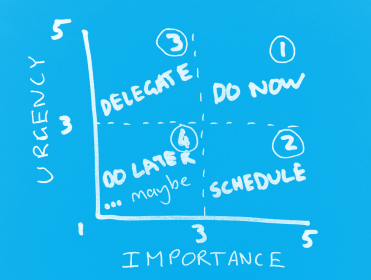Helping organisations and individuals organise and improve their communication processes through analysis, project management, mediation and training.
Blog (Tag: Efficiency)
We all suffer from the same problem: How do you manage your to-do list and prioritise your tasks? All too often we are confronted with the feeling that everything needs to be done RIGHT NOW. But usually this feeling is wrong. Dwight Eisenhower once correctly said
“What is important is seldom urgent and what is urgent is seldom important.”
So how can we prioritise our to-do list properly then, and work more efficiently? One tool to help might be the Eisenhower Decision Matrix, shown in the image.
A few simple steps (my adaptation of the prioritisation method) can help you take control of your task list, as I explain in this post.
The first thing that’s important to distinguish is the difference between Urgent and Important. People often confuse the two or think they are the same thing, but they are quite different.
Importance describes how much a certain task will contribute to your overall goals and objectives, whether it’s advancing your career, completing a project or getting new contracts. Something that will have no effect if it doesn’t happen is simply not important.
Urgency describes how soon something has to be done before it becomes “too late”. Some things can be done two days from now, and the outcome will remain the same, whilst others (like paying your taxes on the deadline) need to happen NOW or it’s simply too late.
Once you understand the difference between urgent and important, you can start categorising your tasks.
- For each task on your list, grade it both in terms of urgency and importance, from 1-5, with 5 being the highest importance or urgency.
For example, if you have a task to apply for your dream job, and the application deadline is this afternoon, it would get a 5 for both categories. If the deadline is in 2 weeks, you can probably give it a 5 for importance, and a 2 for urgency. - Next, plot your tasks in the matrix shown in the image.
- The last step is deciding what to do with each task, and this is made easier by dividing the graph into 4 quadrants, with each quadrant having its own “prioritisation rule”. Note that this is my personal adaptation of the method, and I suggest you adapt it to fit your own situation as well.
- Quadrant 1 “Do Now” – This is the quadrant you do not want your tasks to be in. It’s a stressful quadrant where tasks cannot wait, and as the title suggests, these are tasks that are the highest on your list of priorities. Get them done now!
- Quadrant 2 “Schedule” – This quadrant contains items that are important, but they’re not urgent yet. So make sure they don’t become urgent! Schedule them in now, so you can get them done before they do. These items go second on your list of priorities.
- Quadrant 3 “Delegate” – These items are urgent, but they’re not very important for your own goals. This often means you can delegate them, because even if they go wrong, the impact on your goals are minimal. If you cannot delegate in your situation, then schedule them for yourself, but lower than the items in quadrant 2.
- Quadrant 4 “Do Later” – This quadrant contains things that maybe should not even be on your list. They are items that are not important to your goals, and are not pressing to happen. Add these to the bottom of your list, and if you never get to them, too bad. Chances are, nothing will go wrong if you don’t do them.
Now of course there are exceptions to these items, and there are considerations when items fall in-between quadrants. In this case, use your common sense and your own discretion when prioritising.
Next time you’re busy with your to-do list, try using these tips, and watch how your tasks seem so much more manageable. You might even be surprised at the number of things on your list that are simply not necessary!
You can be more effective! You can be happier! With these 7 habits you can be successful!
These are all slogans books have that claim to help you be better, more efficient and happier. And the truth is, most of these books have very valid points, if you can incorporate the tips into your life and workflow. But in the end, they all talk about success.
Scott Adams (the Dilbert guy) wrote his own “book of tips” with a bit of a twist. Though he is known for his humour in the Dilbert comics and his books, his latest book (How to fail at Almost Anything and Still Win Big) is more of a life story, full of anecdotes and simple tips, all leading to his own theory: “Goals are for losers, systems lead to success!”
Though it might sound like it, I am not specifically trying to promote this book, nor do I have any financial interests in it. I'm just a fan of Scott Adams and his work, and thought I'd share my thoughts!
I’m not sure which category this book falls under; autobiography, self-help, philosophy, health… but I found it an entertaining and enlightening read. The reason is simple…
The book was simple to read. It is full of short stories of Scott’s own experiences, and how he dealt with them. Every now and then he gives some reference to back his ideas, but in general the book is just full of common sense (some say the least common of the senses…). So if it’s full of common sense, why read, or even buy it?
Because you don’t realise these things until you read them in a book. It awakens things in your mind that you don’t really realise are there. And then it makes you think, and it makes you recognise situations in your own life where his tips might apply.
And that’s basically it. There’s no grand story here, and life-changing tips or Nobel Prize winning ideas (though he’d love to win that one day). Just common sense that’s very worth reading.
Scott goes into various different aspects of his life, with a big focus on eating and living healthy, and how that can lead to a better life in general. There are a few chapters on weight loss and the systems (rather than goals) that can help. Scott did a good job on relating healthy eating to other aspects of your life which I found very interesting.
So whether you’re just curious, whether you’re looking for any tips to be more effective, or whether you want to lose weight, I suggest you pick up a copy of this book, and enjoy it!
Business nowadays is inextricably linked to information systems that manage everything. Software systems make everything possible, automating the simplest of tasks. This makes things easier right?
Unfortunately, that’s not always the case. Too often, companies conform to the demands of the IT solution, rather than implementing an IT solution to complement the existing processes. Consider this letter I got from American Express:
English Translation:
Due to a technical error, we are not able to notify you by email that your monthly account statement is available online. That is why we are sending you a paper version by regular mail. Our apologies for the inconvenience.
You do not need to take any action. Next month, you will receive an email again to notify you that your monthly account statement is online.
If I understood it correctly, which I’m sure I did, I am getting a document by mail (~€1,20 postage) to say that since AmEx was unable to notify me of the availability of my statement online by e-mail, they are sending the whole statement by regular mail. The statement was still available online, they just couldn’t tell me about it. I wonder, was it easier to send thousands of actual letters than pressing another send button in the software to send the e-mails? Clearly something is wrong there?
I had a similar situation with Vodafone, my mobile phone carrier...
Somehow an error in calculation meant that I need to get €0.23 credited. They sent me a regular mail letter to inform me of this, rather than an e-mail like my normal invoices from Vodafone. When I asked the service agent about it, the reply was something like “It would cost a lot of money to adapt the software to enable that.” Doesn’t that sound odd?
So why do huge companies like AmEx and Vodafone get it wrong? Do they buy the wrong software? Probably not. Do they hire cheap implementers? I don’t think so. The problem probably arises in the implementation step. Management often needs to show quick progress when implementing new software, causing them to rush through “less important” parts of the project.
I recently became an Authorised Partner of Podio, an online collaboration and team-work tool. When implementing Podio, one of the most important first steps is a full inventorisation of the business processes in a business. Only once you have those clear can you implement a solution adequately. And that’s the beaty of Podio (with the motto “Work they way you want to”); it can be adapted to fit the needs of the organisation, with the ability to easily create the apps you need to support your existing business processes.
Interested in taking a look at Podio and seeing what it can mean for your organisation? Contact me, and we’ll see what the possibilities are!
Anyone driving around at night in The Netherlands lately will have noticed that it is considerably darker than it used to be. Why? Because the Dutch government implemented one of their many plans to save money and help us out of the economic recession. Apparently turning off the lights on the motorways at certain hours in areas where there is less traffic will save us € 35m annually. € 35m, a very large sum of money that was being used simply to keep the asphalt lit. The first thing that came up in my mind when I heard this news was: "Why only now?".
Why did we need a recession, 4 years of a recession before someone decided that we are wasting money with a solarium for empty tarmac? In some northern provinces, and many countries around the world, it is perfectly normal to have unlit highways.
This is a classic example of how a crisis can lead to innovation. Rahm Emanuel said "Never let a good recession go to waste", and he was right. We apparently needed to brainstorm for ways to improve the economy for 4 years before someone thought of this idea.
Maybe that's a lesson for all of us... Instead of just thinking how we can get more clients, bigger projects and in the end more money, maybe we should imagine what we would do in a crisis. What if your product suddenly is offered for free by Google? What will you do then? Innovate, and you will more forward!
"If you're not moving forward, you're standing still."




